
A cartoon is a type of visual art that is typically drawn, frequently animated, in an unrealistic or semi-realistic style. The specific meaning has evolved, but the modern usage usually refers to either: an image or series of images intended for satire, caricature, or humor; or a motion picture that relies on a sequence of illustrations for its animation. Someone who creates cartoons in the first sense is called a cartoonist, and in the second sense they are usually called an animator.
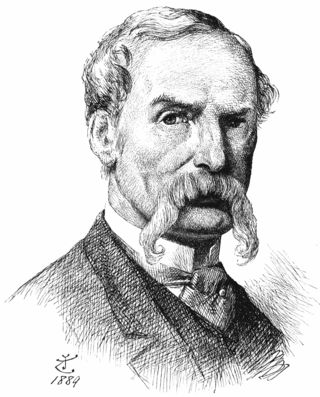
Sir John Tenniel was an English illustrator, graphic humourist and political cartoonist prominent in the second half of the 19th century. An alumnus of the Royal Academy of Arts in London, he was knighted for artistic achievements in 1893, the first such honour ever bestowed on an illustrator or cartoonist.

Punch, or The London Charivari was a British weekly magazine of humour and satire established in 1841 by Henry Mayhew and wood-engraver Ebenezer Landells. Historically, it was most influential in the 1840s and 1850s, when it helped to coin the term "cartoon" in its modern sense as a humorous illustration. Artists at Punch included John Tenniel who, from 1850, was the chief cartoon artist at the magazine for over 50 years.
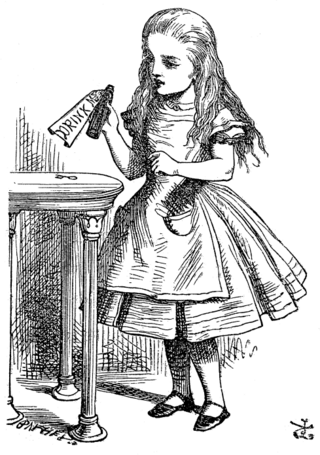
Alice is a fictional character and the main protagonist of Lewis Carroll's children's novel Alice's Adventures in Wonderland (1865) and its sequel, Through the Looking-Glass (1871). A child in the mid-Victorian era, Alice unintentionally goes on an underground adventure after falling down a rabbit hole into Wonderland; in the sequel, she steps through a mirror into an alternative world.

Britannia is the national personification of Britain as a helmeted female warrior holding a trident and shield. An image first used by the Romans in classical antiquity, the Latin Britannia was the name variously applied to the British Isles, Great Britain, and the Roman province of Britain during the Roman Empire. Typically depicted reclining or seated with spear and shield since appearing thus on Roman coins of the 2nd century AD, the classical national allegory was revived in the early modern period. On coins of the pound sterling issued by Charles II of England, Scotland, and Ireland, Britannia appears with her shield bearing the Union Flag. To symbolise the Royal Navy's victories, Britannia's spear became the characteristic trident in 1797, and a helmet was added to the coinage in 1825.

The General Post Office is the former headquarters of An Post — the Irish Post Office. It remains its registered office and the principal post office of Dublin — the capital city of Ireland — and is situated in the centre of O'Connell Street, the city's main thoroughfare. It is one of Ireland's most famous buildings, not least because it served as the headquarters of the leaders of the Easter Rising against British rule in Ireland. It was the last great Georgian public building to be erected in the capital.

Hibernia is the Classical Latin name for Ireland. The name Hibernia was taken from Greek geographical accounts. During his exploration of northwest Europe, Pytheas of Massalia called the island Iérnē. In his book Geographia, Claudius Ptolemaeus ("Ptolemy") called the island Iouerníā. The Roman historian Tacitus, in his book Agricola, uses the name Hibernia.

A political cartoon, also known as an editorial cartoon, is a cartoon graphic with caricatures of public figures, expressing the artist's opinion. An artist who writes and draws such images is known as an editorial cartoonist. They typically combine artistic skill, hyperbole and satire in order to either question authority or draw attention to corruption, political violence and other social ills.

John Bull is a national personification of the United Kingdom, especially in political cartoons and similar graphic works. He is usually depicted as a stout, middle-aged, country-dwelling, jolly and matter-of-fact man. He originated in satirical works of the early 18th century and would come to stand for "English liberty" in opposition to revolutionaries. He was popular through the 18th and 19th centuries until the time of the First World War, when he generally stopped being seen as representative of the "common man".

The concept of liberty has frequently been represented by personifications, often loosely shown as a female classical goddess. Examples include Marianne, the national personification of the French Republic and its values of Liberté, Égalité, Fraternité, the female Liberty portrayed on United States coins for well over a century, and many others. These descend from images on ancient Roman coins of the Roman goddess Libertas and from various developments from the Renaissance onwards. The Dutch Maiden was among the first, re-introducing the cap of liberty on a liberty pole featured in many types of image, though not using the Phrygian cap style that became conventional. The 1886 Statue of Liberty by Frédéric Auguste Bartholdi is a well-known example in art, a gift from France to the United States.
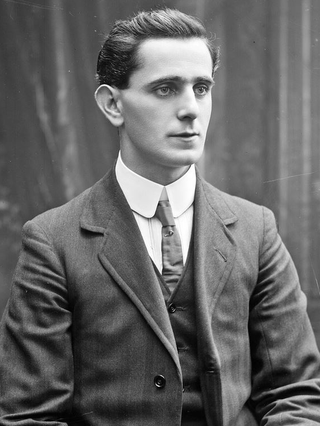
Seán Mac Diarmada, also known as Seán MacDermott, was an Irish republican political activist and revolutionary leader. He was one of the seven leaders of the Easter Rising of 1916, which he helped to organise as a member of the Military Committee of the Irish Republican Brotherhood (IRB) and was the second signatory of the Proclamation of the Irish Republic. He was executed for his part in the Rising at age 33.
Hibernia is the Classical Latin name for the island of Ireland.

A national personification is an anthropomorphic personification of a state or the people(s) it inhabits. It may appear in political cartoons and propaganda.
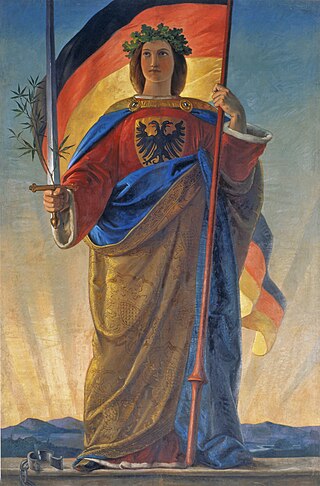
Germania is the personification of the German nation or the Germans as a whole. Like many other national personification symbols, she appeared first during the Roman Era. During the Medieval era, she was usually portrayed as one of the lands or provinces ruled by the emperors of the Holy Roman Empire, and not as the most prominent but in a subordinate position to imperial power and other provinces. Around 1500, together with the birth of the Holy Roman Empire of the German Nation, Emperor Maximilian I and his humanists reinvented her as Mother of the Nation.

Columbia, also known as Miss Columbia, is a female national personification of the United States. It was also a historical name applied to the Americas and to the New World. The association has given rise to the names of many American places, objects, institutions and companies, including the District of Columbia; Columbia, South Carolina; Columbia University; "Hail, Columbia"; Columbia Rediviva; and the Columbia River. Images of the Statue of Liberty largely displaced personified Columbia as the female symbol of the United States by around 1920, although Lady Liberty was seen as an aspect of Columbia. It is the central element of the logo of Hollywood film studio Columbia Pictures.
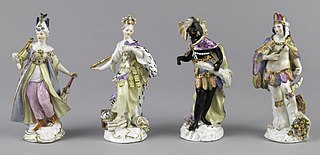
Personification is the representation of a thing or abstraction as a person. It is, in other words, considered an embodiment or an incarnation. In the arts, many things are commonly personified. These include numerous types of places, especially cities, countries, and continents, elements of the natural world such as the trees or four seasons, four elements, four cardinal winds, five senses, and abstractions such as virtues, especially the four cardinal virtues and seven deadly sins, the nine Muses, or death.
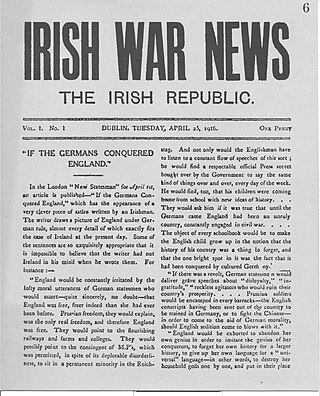
The Hibernian Rifles was a marginal Irish nationalist militia that organised in Ireland in the early years of the 20th Century, having its Dublin Headquarters at 28, North Frederick Street. Its membership were initially Roman Catholic but later opened up membership to any faith.
Banners are a significant part of the Culture of Northern Ireland, particularly for the Protestant/unionist community, and one of the region's most prominent types of folk art. They are typically carried in parades such as those held on the Twelfth of July, Saint Patrick's Day and other times throughout the year. Generally these are organised by societies such as the Orange Order, the Ancient Order of Hibernians, the Royal Black Institution and the Apprentice Boys of Derry, and the banners are typically commissioned by, and represent, a lodge within one of these societies. Banners are also carried by trade unions and church groups, and by marching bands. Most banners are painted by professionals and executed on silk, although canvas was a more popular material in the past. Most have a painting on each side, usually depicting different subjects, and the name and number of the lodge. Most banners have one subject per side, surrounded by flourishes, scrolls, and other decoration. Despite being in many ways a sectarian art form, Catholic and Protestant banners are usually very similar in terms of style and composition. Apart from subject matter, the main difference is colour: Orange Order banners make heavy use of the colour orange and to a lesser extent red, white, blue and purple, while Catholic banners tend to feature a lot of green.

The Friends of Irish Freedom was an Irish-American nationalist organisation founded at the third Irish Race Convention held in New York. Supported by the United Irish League, the Ancient Order of Hibernians and other leading Irish-American organisations. Clan na Gael dominated the Executive.
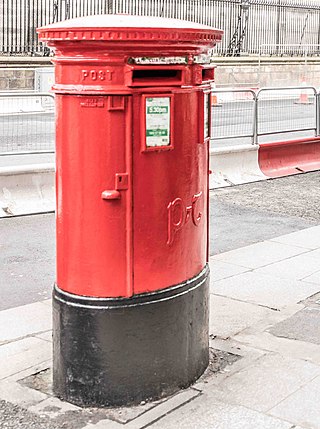
The centenary of the Easter Rising in Dublin, Ireland occurred in 2016. Many events were held throughout the country to mark the occasion.


















